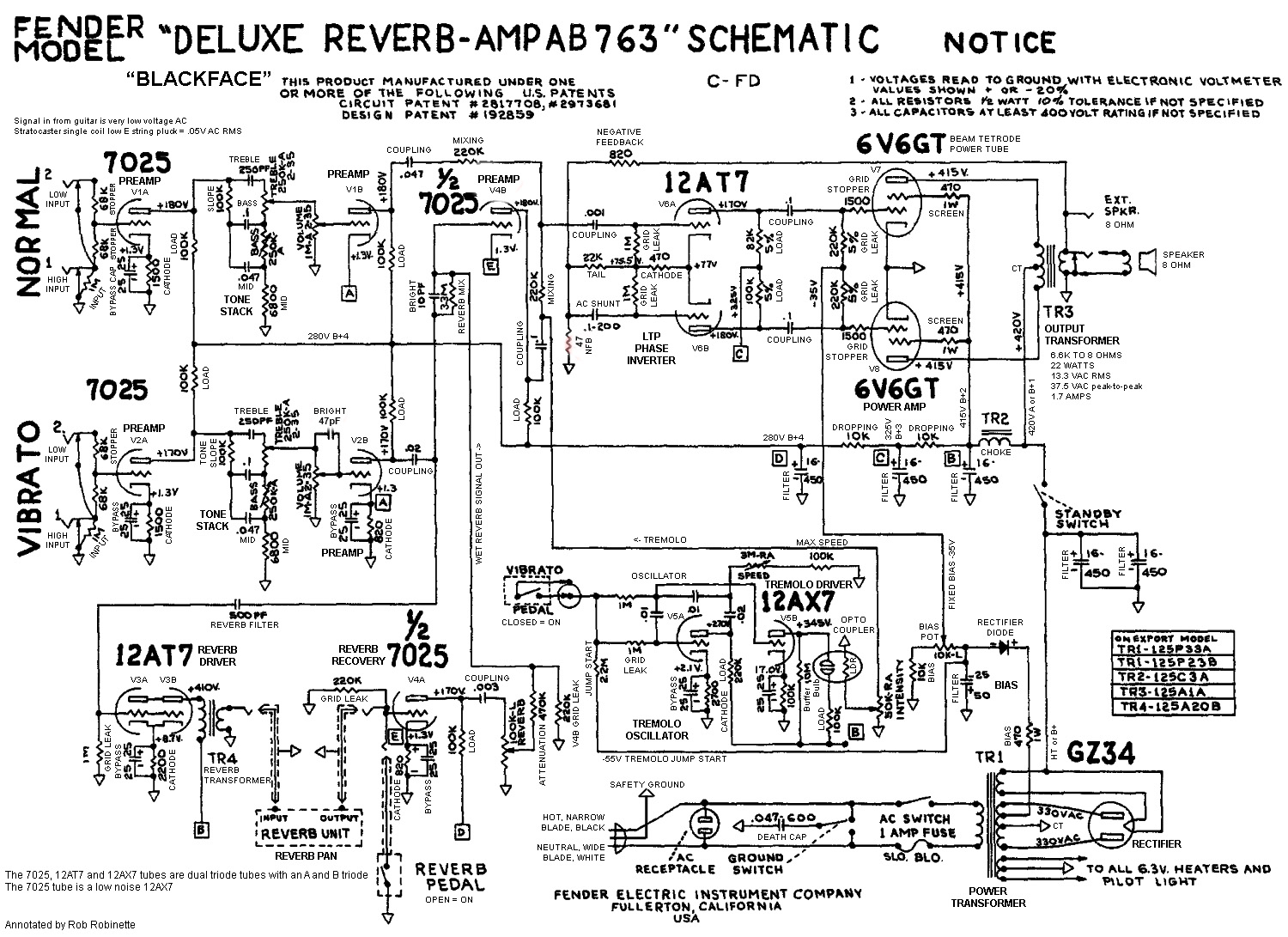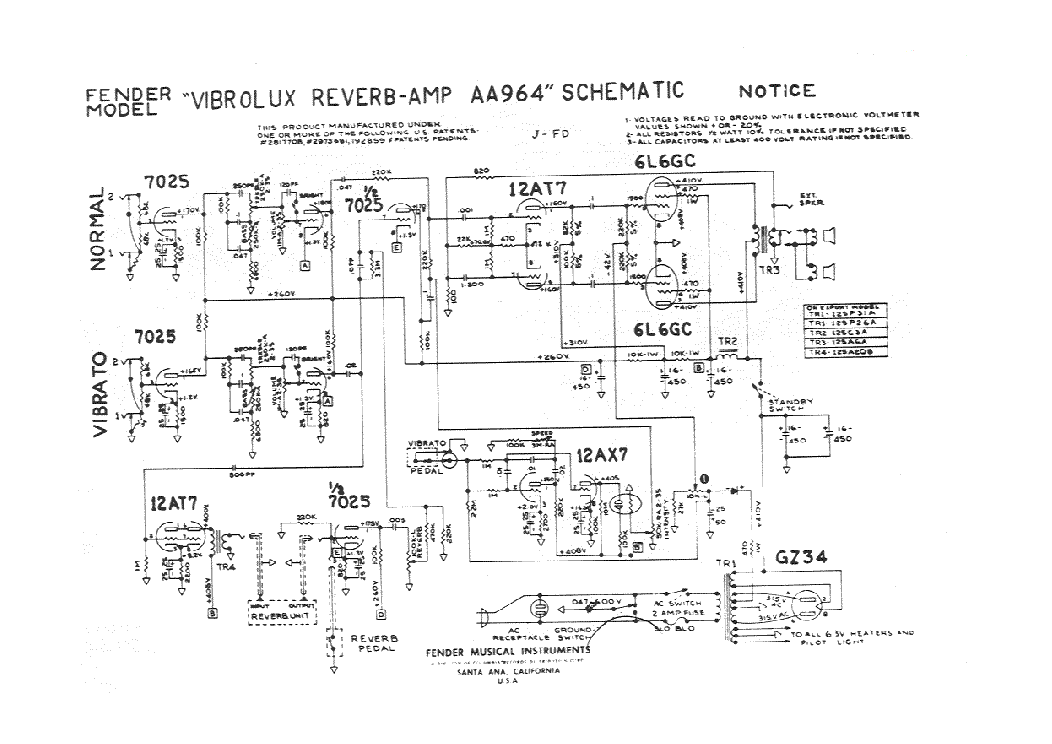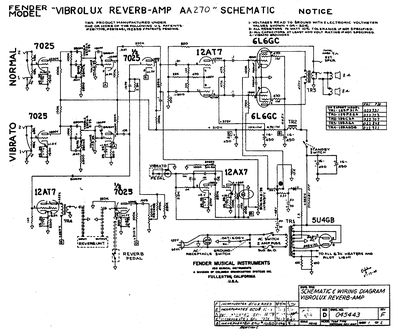-
Would you consider blackfacing a mid 70's silverface VR for swing/bebop in small to medium venues (archtop w/floating pu)?
-
10-17-2018 01:27 PM
-
What circuit does yours have?
I know my Twin Reverb clone profited from changing it to AB763. Easy job, just some caps and resistors. Fully reversible, so yeah, why not give it a try?
(If you can do it yourself, otherwise it might not be worth the costs.....)
-
Little Jay: what does changing to AB763 mean. I have a 70's silver face twin standing around. If the mod would make sense i would consider it too. (I think i could do it myself if i get detailed instructions)
 Originally Posted by Little Jay
Originally Posted by Little Jay
-
Fender indicated their amp circuits with letters and numbers. The AB763 is the classic blackface circuit. You will find this on the schematics of the circuit diagrams, where ‘63 is the year.
But I don’t find an AB763 for the Vibrolux Reverb, so maybe that was brought out later?
Here’s the Deluxe Reverb AB763:

I do find it for the Vibrolux (no reverb yet in ‘63 I guess):

This is the earliest Vibrolux Reverb schematic I found:

So it seems the reverb was added in 1964 to the Vibrolux.
Next change seems to have happened in ‘68, but then it already had Silverface cosmetics:

The last change in 1970:

-
Ah here’s the history of the Vibrolux Reverb. First production year 1964 indeed:
BF/SF Vibrolux Reverb | fenderguru.com
-
The VRs made from 68-72 are great sounding amps. They seem not to break up so quickly as the old blackface versions. I have gigged with both. For jazz, give me a '70 VR. For playing a 335 in a blues band, give me a '64 VR.
-
AB763 basically means the circuit used for most Fender amps in roughly the 1963-67 era. There are exceptions. I have a 1968 silver face “drip edge” Bandmaster that has blackface innards, down to the cloth-covered wires.
 Originally Posted by JazzNote
Originally Posted by JazzNote
I also have a 1974 silver face 100 watt Twin Reverb with master volume, before they went to the 135 watt “ultralinear” circuit. For the silverface circuit, Fender lowered the voltages to the preamp tubes. They changed the phase inverter component values quite a bit, which I suspect was to recover some of the gain lost in the preamp. I haven’t directly compared the sound of a blackface vs. silverface Twin, but I suspect the silverface is a little cleaner, a little brighter and a little bassier. But the silverface sounds amazing — just set the treble, bass and reverb controls fairly low and I’m in heaven.
The most important thing in getting good tone out of an old tube amp is making sure all the electrolytic capacitors, carbon resistors and tubes are are good (and correctly biased). Choice of speakers is critical too. If you want to change to the blackface circuit that’s fine, but on the master-volume Twin that might be more that a handful of components. After recapping and retubing mine and replacing a few aging resistors it sounded so good I didn’t see any need to blackface it. And I wouldn’t remove the master volume. I like using it when playing at lower volumes, and when it’s turned fully up it’s basically out of the circuit. The “pull boost” switch on the master volume knob is totally useless, but if you leave it pushed in it’s totally out of the circuit, too.
Here are schematics for the various silverface Twin Reverbs:
1968-1982 "Silver Face" Twin Reverb
...and the blackface:
1963-1967 "Black Face" Twin Reverb
Sorry to head off on a tangent about silverface Twins when the OP is about the Vibrolux. If we talk much more about them we should probably start a new thread.Last edited by KirkP; 10-17-2018 at 11:33 PM.
-
CBS started ‘improving’ the amps about 1968. They started with the big ones - Twin, Showman, Super - and over the years worked down the line. The circuit changes were not user-visible until they added the master, then the pull-boost, and finally ultra linear output. The Vibro Champ is (as I recall) nearly unchanged, other than the addition of a snubber cap on the 6v6.
The Vibrolux (yes, the circuit is 964, but it is basically a 763 circuit) got a pull-boost, but never a master or ultra linear. It did get the general circuit changes.
‘Blackfacing‘ may not be a good idea - it depends what you are after. If you are looking for clean tones, you may actually be happier with a silver face circuit. The SF phase inverter, for example, might suit you better. Don’t blackface an amp just because “everyone” says you should.
what is true is that the later the amp is, the poorer the lead dress is. Messy wiring leads to oscillations, and rather than cleaning up the wiring, CBS often opted for snubbing tricks, some of which affect the tone of the amp.
My first good amp was a SF VBR (no pull boost) and it was a very fine amp that I wish I had never sold. My free advice to you is to play it as-is and decide what it is you don’t like, and when you have this fixed in your mind, go to a GOOD tech and discuss it with him.
Kirk’s comments are correct. All the electrolytics are 40 years old and should be replaced, if not already done. Carbon comp resistors can drift significantly in 40 years and should be checked. Coupling capacitors should be checked for DC leakage and replaced only if necessary. You are in the Netherlands so I assume it as a grounded cord and no ground switch.
Steven
-
@ Greentone: "...For jazz, give me a '70 VR..." Because of the later break up or for sound considerations?
@ KirkP: Filter caps are fresh, no issues with drifting components etc. I can't say if the guts are messed but they look decent....no pull boost; amp looks very well cared for.
@ Stevo58: Very informative reply, thanks. I play my SFVR blackfaced but I think I liked it more when still was only partly blackfaced (i.e. with PI and tone stack silverface IIRC). But I'm not sure...may have been the speakers..Hence my question for other SFVR/archtop users.
-
If you plan to work on a Fender amp or even if you’re planning to bring one to a tech, I’d recommend watching a few of this guy’s videos to get an idea of what’s involved, especially the ones where he is working on handwired Fender amps. He’s good. He’s working on a Vibrolux here, but there are others where he is replacing leaking caps and out of tolerance resistors.
I think often people play silverface amps that have not been well maintained or poorly modded, get them blackfaced and conclude that the silverface circuits suck when the actual problem might have been out of spec components and perhaps poor wiring practice at the factory.
Job #1 for working on amps is understanding how to safely discharge electrolytic caps. I accidentally touched a 500 volt power supply lead as a teen, and it wasn’t fun. If my other hand had been touching a ground I might not have survived it.
Edit — Here’s a great resource for tutorials on how tube amps work, nearly math-free:
Last edited by KirkP; 10-18-2018 at 04:06 PM.
-
I had a ‘64 BFVR for many years and, regretfully, I sold it. It sounded great and had enough headroom for me, at the fairly low volume I play at in small venues. Because I missed it so much, I eventually replaced it with a 1973 SFVR. Mine was made before the push/pull volume circuit and I’m quite happy with it. It is a really nice sounding amp with lots of headroom. I think I may have gotten a little nicer tone with the BF, but there’s certainly nothing wrong with a good SF from the early 1970’s. For a clean jazz sound, there is no need to make any mods to this amp IMO.
 Originally Posted by Greentone
Originally Posted by Greentone
Keith
-
No. The only modification I'd recommend would be to replace filter caps, re-tube with quality glass, replace other worn components, and do whatever makes the amp sound the way YOU like it to sound.
 Originally Posted by jpb
Originally Posted by jpb
-
I have gigged with three different VRs. (1) a 60s blackface with two Oxford/Jensen (not sure) 10" speakers--back when I was primarily using a Telecaster. (2) an early-70s silverface with two Ox/Jen 10" speakers (again, not sure). (3) a '66 blackface with two EV Force 10" speakers. This was over a 20-year period. I used everything from Telecasters, Stratocasters, Gretsch CA6120 guitars, Gibson ES-175 and ES-335 guitars into these amps.
For blues/rock I had a strong preference for #1, using either the Telecaster or the 335. This is a "made in heaven" rig, to be sure. The clean voice is unbeatable and the distortion signature is...Roy Buchanan--'nuff said.
For an ES-175 gig, I strongly preferred #2. The slightly later breakup and slightly cleaner cleans of the silverface (as I perceived it) was perfect for the 175. The two tens were better suited for the archtop (IMO) than was the silverface Pro Reverb I used to use. (Same amp, but two 12" speakers instead). I don't think that the extra low-end heft of the twelves was useful on stage with the archtop. I fit into the trio better (piano/bass/guitar) with the tens.
#3 was just a very interesting amplifier. I had never played through EV 10" speakers before or since. I played in a band with synth/keys and horns in this instance. The "cut" of the EV speakers with the mid-power Fender amp was pretty impressive. Ordinarily, I would have favored a Super Reverb, or even a Twin Reverb in this band.
If I could have any of these amps, again, I'd probably pick #1 (collectible) and flip it for #2 and a silverface Princeton.
-
Here’s a report of someone’s experiments with an early silverface Twin Reverb AA270 — the circuit without master volume. They decided against a full conversion to AB763 based on their ears. Not sure if his preferences would be mine, but I like his methodical approach.
 Originally Posted by JazzNote
Originally Posted by JazzNote
http://infernalracketstudios.com/BFIndex.htm
-
If you are still using the original speakers, they may be pretty worn out after 40 years. Speakers have a HUGE effect on your tone. At the moment, my favorites for classic Fender cleans are Jupiter speakers, which are made by WGS to Jupiter specs. Nice piano-like bass, pearly highs without ice, just nice speakers. But again it depends on what you are looking for. There are so many different and good speakers on the market right now, you will go broke trying them all....may have been the speakers..Hence my question for other SFVR/archtop users.
steven
-
There are four very different schematics for Vibrolux Reverbs online. There are many differences between them, and some have a different power transformer with different voltages. None are marked AB763, but the one that looks earliest and most similar to AB763 circuits (with adjustable bias voltage instead of bias balance) is labeled AA964. It has much lower voltages on the 6L6GC Output tubes than most AB763 amps. AB568 came next and is also from the “blackface” era. It has a higher voltage power transformer.
 Originally Posted by jpb
Originally Posted by jpb
You’ll need to determine which circuit you have and decide whether AA964 or AB568 would be an improvement. If you must change the power transformer add $100 or more to the conversion.Last edited by KirkP; 10-19-2018 at 01:00 PM.
-
LittleJay missed this Vibrolux Reverb schematic.

It’s the most recent of the silverface era with master volume. Based on a quick study, it’s very similar to my 74 Twin Reverb circuit, other than having two output tubes instead of four. Since I love my Twin (other than the weight and way more power than I need) I’ll bet I’d like that Vibrolux even better. It’s far from blackface though.
The only thing I’d do to that model is have all the components checked and replaced if needed and add a bias voltage pot. That rectifier tube will drop the voltage when the amp is pushed, adding some compression. If you don’t like that it could be replaced with a solid state rectifier that plugs in the same socket, but you must adjust the bias voltage when you do that.
Bias voltage adjustment could be a thread of its own. You’ll find much advice, good and bad. Biasing too “cold” causes an unpleasant distortion. Biasing hot sounds great, but too hot and the life of the output tubes will be reduced. I’ve actually played through my Twin as the bias was being adjusted, and it does make a difference.Last edited by KirkP; 10-20-2018 at 10:40 AM.
-
Thanks for your contributions but unfortunately I'm not qualified to work on amps and I don't read schematics so I can't tweak it bit by bit to find out the best settings.
But from your comments I read that blackfacing is not per se necessary to play clean jazz with a VR. Speaker swap and fresh filter caps are recommended.
Thanks again.
-
Sounds about right
-
IMO blackfacing it would make it somewhat less suitable for jazz. Most jazz guitar players want clean headroom, and blackfacing means less of that. Rockers, who want lots and lots of distortion and breakup, are mainly the ones who want blackface specs. At least that's the way it seems to me, from the somewhat limited experience I have.
-
Blackfacing a Twin is preferable for jazz imho. But a Twin has so much clean headroom to spare that the change of tone timbre probably outweighs the loss of clean headroom (even with a Blackface Twin you will hardly ever push it to the point of breakup).
A Vibrolux has a lot less power and a lot less headroom - especially the early ones that also have a smaller output tranny and less efficient rectifier tube - so maybe blackfacing one pushes it too much into to the ‘grind-territory’.Last edited by Little Jay; 10-20-2018 at 04:43 PM.
-
In my opinion, out of spec resistors, sagging power supplies, floppy speakers, etc. are the elements of vintage amplifier sound. If you replace everything with new components, one might just build from scratch and use a new chassis with good ground points, fresh tube sockets, safe power cord, etc.
-
When you put it like that, vintage sound just means an amp functioning the way it wasn’t meant to. And depending on the margins of drift in the components it might sound great, or it might sound like crap....... I’m not sure if I agree or not.... I restored two old german amps with new caps and resistors, so up to specs of the original schematic, and I think they sound superior to anything modern.....
 Originally Posted by icr
Originally Posted by icr
-
True, if you have an old amp that you love you might find it doesn’t sound quite the same with the drifting components replaced. But if the components are on the verge of failure or are continuing to drift, you’ll lose that magic sooner or later anyway. To avoid that, one could measure the value of each component one removes and replace it with a more reliable modern component of the same out of spec value. I’ll bet there are few amp techs that offer that service.
 Originally Posted by icr
Originally Posted by icr
[Edit — Mercury Magnetics claims to do something like this with their “ToneClone” transformers, finding examples of vintage output transformers that people seem to particularly like and attempting to replicate them including any variations due to factory tolerance or aging. Pickup builders and speaker manufacturers often claim to do the same. The same approach could be applied to amp building or restoration with the objective not of returning all components to spec, but to replicate a particularly well reviewed amp specimen, including any departures from spec.]
But the OP was asking about blackfacing an amp. Presumably that’s because he’s not pleased with it as it is. My main point was that before he make major changes to it by blackfacing, he should first make sure the problem isn’t due to failing components. If he does decide to blackface the amp using modern components, he’ll end up with an in-spec amp, not an amp that happened to drift to a state of hypothetical vintage mojo.Last edited by KirkP; 10-21-2018 at 01:51 PM.
-
Just to clarify: Like I mentioned in the opening post, my VR is a mid 70s amp. So the model is AA270, and pre-pull boost. And as far as I know, the power and output transformators are the same types as in the BFVR. I played the amp in several semi-blackface and blackface modifications (done by a competent tech), and with a variety of speakers. But I'm still not getting the tone I'm after. So restore it to original silverface condition is an option. Hence my initial question if someone has experience with silverface and blackfaced VR. I'm sorry if my question in the opening post was not clearly stated..
Note: In all situations there was more than enough headroom. The music I play is not very loud; Vol. knob is at 3 max.




 Reply With Quote
Reply With Quote







Has anyone played or had a Supro Amulet ?
Today, 04:44 AM in Guitar, Amps & Gizmos